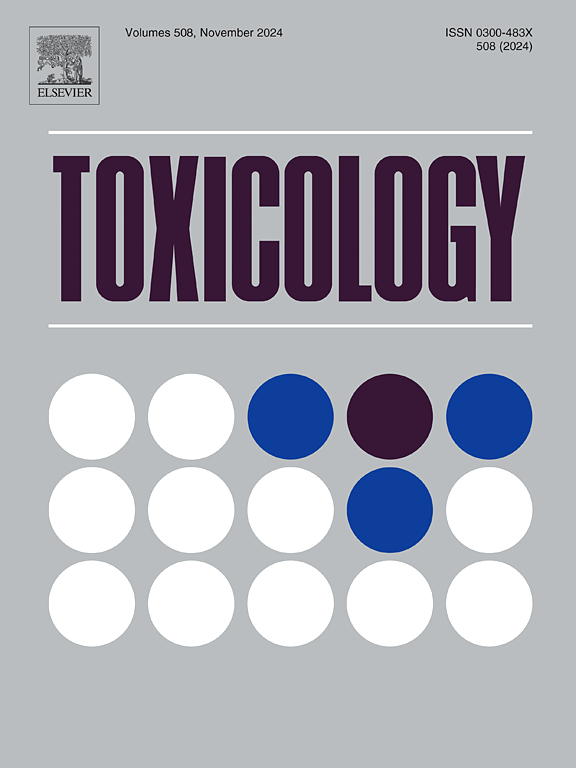乙醇暴露损害了人类前脑类器官的顶端放射状胶质细胞的有丝分裂和早期皮质发育:乙醇诱导的小头畸形的意义
IF 4.6
3区 医学
Q1 PHARMACOLOGY & PHARMACY
引用次数: 0
摘要
母体酒精暴露可严重破坏神经干/祖细胞的分化,导致神经元数量减少,皮质层的体积和厚度减少,这是通常与小头畸形相关的一个标志性特征。我们实验室最近的研究表明,乙醇暴露干扰了放射状胶质过程的形成,并损害了人类前脑类器官外放射状胶质细胞的产生和迁移。然而,乙醇影响外放射状胶质细胞产生的确切机制尚不清楚。本研究以人类前脑类器官为研究对象,探讨乙醇暴露对放射状胶质细胞有丝分裂和皮质发育的影响。我们的研究结果显示,乙醇暴露显著减少了根尖放射状胶质细胞的有丝分裂细胞分裂。暴露于乙醇也显著减少对称细胞分裂,同时增加这些细胞的不对称细胞分裂。此外,乙醇暴露减少了前脑类器官中外放射状胶质细胞的数量,表明乙醇暴露通过破坏根尖放射状胶质细胞的有丝分裂而损害了外放射状胶质细胞的产生。我们的研究结果还表明,乙醇诱导的顶端放射状细胞有丝分裂分裂的中断以及随后放射状外胶质细胞的减少导致发育中的皮质壁厚度减少,导致前脑类器官变小。这项研究极大地促进了我们对乙醇诱导的小头畸形的细胞机制的理解,并为开发新的干预措施提供了潜在的途径,以预防或减轻与产前酒精暴露相关的神经发育缺陷,包括乙醇诱导的小头畸形。本文章由计算机程序翻译,如有差异,请以英文原文为准。
Ethanol exposure impaired mitotic division in apical radial glial cells and disrupted early cortical development in human forebrain organoids: Implications for ethanol-induced microcephaly
Maternal alcohol exposure can severely disrupt the differentiation of neural stem/progenitor cells, leading to a reduced number of neurons and decreased volume and thickness of the cortical layers, a hallmark feature commonly associated with microcephaly. Recent studies from our laboratory have demonstrated that ethanol exposure interfered with the formation of radial glial processes and impaired the generation and migration of outer radial glial cells in human forebrain organoids. However, the precise mechanisms by which ethanol affects the production of outer radial glial cells remain unclear. In this study, human forebrain organoids were used to investigate the effects of ethanol exposure on the mitotic divisions of radial glial cells and cortical development. Our findings revealed that ethanol exposure significantly reduced mitotic cell division in apical radial glial cells. Exposure to ethanol also significantly decreased symmetric cell division while increasing asymmetrical cell division in these cells. Additionally, ethanol exposure reduced the number of outer radial glial cells in forebrain organoids, suggesting that ethanol exposure impaired the production of outer radial glial cells by disrupting the mitotic division of apical radial glial cells. Our findings also revealed that ethanol-induced disruptions in mitotic cell division in apical radial cells and the subsequent reduction in outer radial glial cells contributed to the reduced thickness of the developing cortical wall and resulted in smaller forebrain organoids. This study significantly advances our understanding of the cellular mechanisms underlying ethanol-induced microcephaly and provides potential avenues for developing novel interventions to prevent or mitigate the neurodevelopmental deficits associated with prenatal alcohol exposure, including ethanol-induced microcephaly.
求助全文
通过发布文献求助,成功后即可免费获取论文全文。
去求助
来源期刊

Toxicology
医学-毒理学
CiteScore
7.80
自引率
4.40%
发文量
222
审稿时长
23 days
期刊介绍:
Toxicology is an international, peer-reviewed journal that publishes only the highest quality original scientific research and critical reviews describing hypothesis-based investigations into mechanisms of toxicity associated with exposures to xenobiotic chemicals, particularly as it relates to human health. In this respect "mechanisms" is defined on both the macro (e.g. physiological, biological, kinetic, species, sex, etc.) and molecular (genomic, transcriptomic, metabolic, etc.) scale. Emphasis is placed on findings that identify novel hazards and that can be extrapolated to exposures and mechanisms that are relevant to estimating human risk. Toxicology also publishes brief communications, personal commentaries and opinion articles, as well as concise expert reviews on contemporary topics. All research and review articles published in Toxicology are subject to rigorous peer review. Authors are asked to contact the Editor-in-Chief prior to submitting review articles or commentaries for consideration for publication in Toxicology.
 求助内容:
求助内容: 应助结果提醒方式:
应助结果提醒方式:


